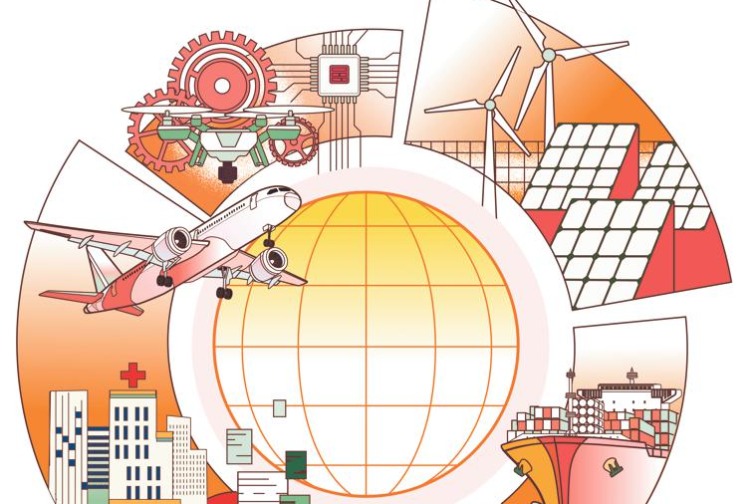Festival consumption can boost economy


In mid-January, the National Development and Reform Commission, China's top economic planning body, pledged to take measures to boost consumption during the Spring Festival holiday. The NDRC has also been promoting the shopping season for the traditional Spring Festival and Lantern Festival along with Valentine's Day.
There is a common denominator between the traditional, joyful festivals and variant invasions. That denominator is demand-the effort to recover the pre-pandemic demand level despite the emergence of new novel coronavirus variants and sporadic infection outbreaks.
Around the world, retailers aspire to reinforce sales during major holidays, which have a "multiplier effect" on revenue generation. Such efforts boost holiday spending in the immediate term. But the multiplier effect is more extensive when the authorities implement additional policy measures to foster consumption.
With new COVID-19 flare-ups in several cities, including Omicron infections in Beijing and Tianjin, the NDRC has taken measures to increase holiday spending, in order to boost the economy in the first quarter of this year.
During this year's 40-day peak travel season (chunyun)-the world's largest human migration-people are expected to make some 1.18 billion trips (36 percent increase relative to 2021). About 260 million passenger trips have already been made during the first 10 days of the festival (46 percent more than in 2021). With air travel increasing by more than 40 percent during the seven-day holiday, the holiday season is contributing to the sector's rebound. As for consumption, it increased 29 percent in Shanghai alone.
The "new post-pandemic normal" is creating challenges worldwide, due to the triple pressure from shrinking demand, disruptions in supply and weakening expectations. In December, US retail sales fell despite the holiday shopping season. However, strong sales by Amazon suggested robust e-commerce potential.
In China, too, Spring Festival online sales have shown strong growth, boosted by ice and snow tourism and the Beijing 2022 Winter Olympic Games, particularly by "Gen Z" (those born between 1995 and 2009). In fact, early online payment transactions suggest growth of up to 5.3 percent relative to 2021(11.6 percent in terms of value).
When China managed to contain the COVID-19 pandemic in early 2020, most of the fewer than 90,000 cases were on the Chinese mainland. Today, due to the West's failure to contain the pandemic, the number of confirmed cases worldwide has crossed a whopping 400 million.
Since the spring of 2021, many advanced economies have made significant progress in vaccination. In contrast, most emerging markets and developing economies have had a much slower rollout, hampered by the lack of supply and export restrictions, due to inadequate international cooperation and vaccine hoarding by rich countries.
A protracted pandemic, due to the failure to deliver vaccines and vaccine hesitancy, may further penalize global GDP by a cumulative $5.3 trillion over the next five years. Worse, economic scarring will constrain medium-term performance. True, the global economy is projected to grow 4.4 percent this year, but the risks remain heavily on the downside, because many developing countries are facing five-to-10 lost years in missed output.
After failing to contain the pandemic, the West has largely resigned to an "endemic" COVID-19, which is mistakenly portrayed as gradual improvement, lower infection levels and fewer deaths. In fact, the frequent new infection outbreaks in Western countries create huge population bases for the emergence of new variants. Unlike Omicron, those could be both highly transmissible and more lethal. In that case, recurrent epidemic waves for respiratory transmitted epidemic infections would further penalize the world's most vulnerable economies.
In September 2021, a report by the United Nations Conference on Trade and Development projected that, through 2025, developing countries are likely to be $12 trillion poorer because of the pandemic, with the failure to roll out vaccines likely to knock another $1.5 trillion from people's incomes across the Global South. And due to new policy failures in the West, these losses could increase.
Poor economies will have to pay dearly for the mistakes of rich countries.
Since the global financial crisis, an astronomical amount of $25 trillion has been pumped into advanced economies, while massive fiscal packages have been supported by ultra-low rates and rounds of quantitative easing. And soon, the US Federal Reserve is expected to make a dire situation worse by resorting to faster rate hikes and quantitative tightening.
In such an international environment, China's challenge is to balance efforts at economic rejuvenation with appropriate control measures against existing variants and those that are yet to come. What's needed is a "people come first" approach-yet one that can reduce supply disruptions and sustain optimal employment.
Therefore, China's measures to prop up festival economy are vital to boost consumption and fuel growth-both during and beyond the holiday season.
The views don't necessarily reflect those of China Daily.
The author is the founder of Difference Group and has served at India, China and America Institute (US), Shanghai Institutes for International Studies (China) and the EU Centre (Singapore).































